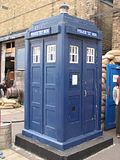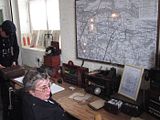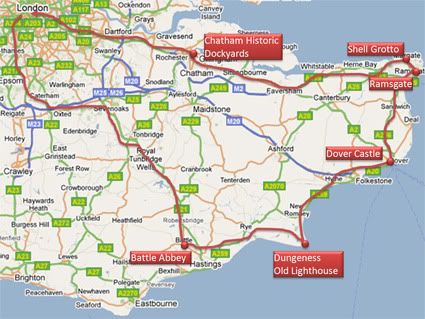
Battle, East Sussex
1066. The perfect PIN for a Englishman.
 In October 14, 1066 William the Bastard (Duke William II of Normandy) defeated the English army of King Harold II and conquered England. He was then renamed William I of England or as we now know him, William the Conqueror. Probably the most splendid account of this part of history is the Bayeux Tapestry.
In October 14, 1066 William the Bastard (Duke William II of Normandy) defeated the English army of King Harold II and conquered England. He was then renamed William I of England or as we now know him, William the Conqueror. Probably the most splendid account of this part of history is the Bayeux Tapestry. 
Sadly that's in Bayeux, which we foolishly forgot to visit it last time we were in Normandy. In England, at the area suitably called Battle, near Hastings, you can walk the whole of the battlefield with pretty good audio commentary and also visit the Abbey.

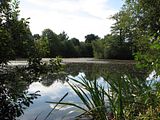

 William the Conqueror himself ordered the construction of the abbey where the Battle of Hastings had taken place, with the high altar of the church on the spot where King Harold fell in the battle. William died before it was completed. The church was finished in about 1094 and consecrated during the reign of his son William Rufus. William the Conqueror had ruled that it was to be exempted from all episcopal jurisdiction, which put it on the level of Canterbury for a while. It was remodelled in the late 13th century but virtually destroyed during the Dissolution of the Monasteries under King Henry VIII.
William the Conqueror himself ordered the construction of the abbey where the Battle of Hastings had taken place, with the high altar of the church on the spot where King Harold fell in the battle. William died before it was completed. The church was finished in about 1094 and consecrated during the reign of his son William Rufus. William the Conqueror had ruled that it was to be exempted from all episcopal jurisdiction, which put it on the level of Canterbury for a while. It was remodelled in the late 13th century but virtually destroyed during the Dissolution of the Monasteries under King Henry VIII.


Dungeness old lighthouse
I don’t know why people get excited about lighthouses but I am definitely one of them! I loooove lighthouses. And the one in Dungeness comes with extras. You can go all the way up, see the mechanisms, learn about procedures and admire the view.

Nearby, you can also see the newer lighthouse. It’s a shame you can't visit the new one but do people get inside lighthouses anymore? As far as I know, there are no lighthouse keepers anymore. No more grumpy rugged men spending their lives inside lighhouses, responsible for saving ships from smashing into rocks and for recognising Soviet ships during the Cold War by profiles hanging on the wall! Inside the lighthouse, there are also maps of the thousands of shipwrecks all around the UK. They make you feel the immense importance that lighthouses have always had in the history of a naval nation.

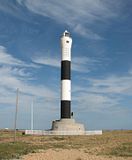



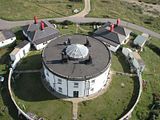

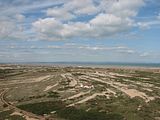

We went there for the lighthouse, but next time it will be for the beach. The beach is vast and absolutely magnificent. I could walk there for hours. I had never seen this part of England before and the area reminded me of movies and books about the sea, uninhabited islands and adventure. To clarify, this is not about swimming and playing beach games. This is better than that.


Driving to Dungeness is quite fun, but by obediently following our TomTom SatNav we almost ended up inside EDF's Nuclear Power Station. There is a quirkier way to get to Dungeness though and without the threat of being followed by men in black suits. A miniature (but big enough for passengers to board) train that gets you there from Appledore (Kent) or Rye (Sussex).
Dover Castle
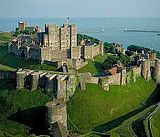 After a while in Britain you get to realise that every castle is different and has its own unique flavour. Dover Castle is unique in that it seamlessly combines the middle ages with the 18th and the 20th century.
After a while in Britain you get to realise that every castle is different and has its own unique flavour. Dover Castle is unique in that it seamlessly combines the middle ages with the 18th and the 20th century. After the Romans invaded, the site contained two Roman lighthouses. It later became the site of Saxon and early Norman hill forts, until 1160, when Henry II began the great stone castle we can still see today. A symbol of power and authority guarding the gateway to England, it was also a palace designed for royal ceremony, where Henry could impress distinguished visitors. One of the most fun castles in the UK.

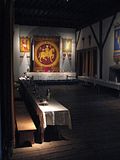


Historians, designers, artists and craftspeople have all worked to present it as it might have appeared
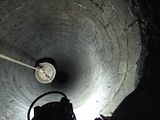 when newly completed in 1184, and ready to receive an important visitor, Count Philip of Flanders. When you step inside you feel like Count Philip of Flanders yourself, as if everything has been prepared for you. Also, one of the most unusual features is the extremely deep well that supplies with water the top floors of the castle.
when newly completed in 1184, and ready to receive an important visitor, Count Philip of Flanders. When you step inside you feel like Count Philip of Flanders yourself, as if everything has been prepared for you. Also, one of the most unusual features is the extremely deep well that supplies with water the top floors of the castle.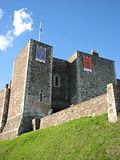
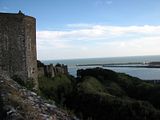


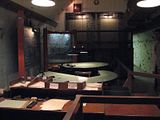
At the same time, world war 2 aficionados can indulge in the underground headquarters where the Dunkirk evacuation was planned. Just like the rest of the castle, these are also impeccably presented.
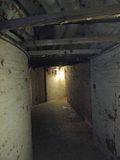

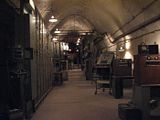
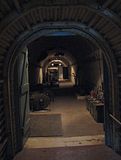
Not far from these tunnels, you can visit the Admiralty Lookout. The ground floor included the Fire Commanders office that controlled the defensive guns of the coast, and the observation room, equipped with a Depression Position Finder to locate ships and stereoscopic binoculars to identify them.


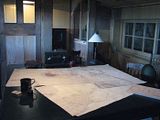

Dover Castle is one of those very few touristic attractions for which one, two or three hours just isn't enough. For example, we didn't have time for the Roman lighthouse or the Medieval tunnels that were adapted by engineers during the Napoleonic war in preparation for French invasion.

We left Dover around six, when the Castle closed, and headed towards Ramsgate to spend the night. For people living in the British countryside, these coal factories are commonplace, but not for me.
Ramsgate

A beautiful coastal town. Unfortunately it seems that the local authorities do not have the means to keep the cultural attractions running and have given up. We wanted to see the naval museum located in a beautiful building at the port, but it has been closed for over a year. Nevertheless the town is worth the visit and I would recommend having breakfast at one of the restaurants facing the marina. We stayed at the Spencer Court hotel. Not great. Not that it matters for one night though.
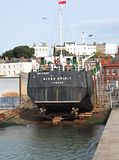

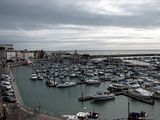


Next, Margate and its hidden gem.
Margate Shell Grotto
Margate is so close to Ramsgate, you may not realise you change towns when you drive between the two. We visited Margate for what is probably the hidden gem - highlight of this trip. The Shell Grotto. We arrived at what looks like a normal gift shop with an obvious preference to sea shells.
 But when you step inside, you notice a small display room explaining the theories behind the Shell Grotto, and then the underground entrance. Follow the steps and you find yourself in the most spectacular place. Something like an ancient pagan crypt, decorated solely with sea shells; 4.6 million of them. It is considered to be some kind of temple, but nobody really knows when and who build it or what it was really used for. It was discovered in 1835 by some kids whose father was renting the house and garden above. When the father found out where his kids were hiding every afternoon, he kept it a secret and managed to buy it off the owners.
But when you step inside, you notice a small display room explaining the theories behind the Shell Grotto, and then the underground entrance. Follow the steps and you find yourself in the most spectacular place. Something like an ancient pagan crypt, decorated solely with sea shells; 4.6 million of them. It is considered to be some kind of temple, but nobody really knows when and who build it or what it was really used for. It was discovered in 1835 by some kids whose father was renting the house and garden above. When the father found out where his kids were hiding every afternoon, he kept it a secret and managed to buy it off the owners. He then revealed the Shell Grotto to the public and opened it as an attraction to paying customers in 1837.
He then revealed the Shell Grotto to the public and opened it as an attraction to paying customers in 1837.Many spooky and intriguing things about it, but my favourite is a picture displayed at the shop, of a séance performed inside the Grotto about 100 years ago, with the text reading: "Do you know any of these ladies?".



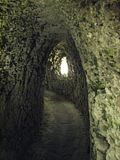


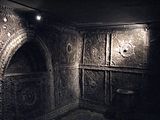

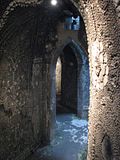
From its official website:
Was the Grotto a rich man’s folly?
A popular theory with some, who cite the popularity of follies and shell structures in the 1700s. There are lots of them dotted around the country, largely in the grounds of stately homes, and this is certainly a convenient theory but one that is flawed because:
• The land the Grotto lies under was farmland and has certainly never formed part of a large estate. So why would a rich man’s fancy be built under someone else’s pastureland?
• Follies were built as a statement: look at how much money I have, look at how cultured I am, look at me! In general, they weren’t secret, hidden away places. And they weren’t built under a farmer’s field.
• Crucially, if the Grotto had been built in the 1700s how could all knowledge of it have disappeared by the time of its discovery in 1835? The building of the Grotto would have been a mammoth task: the excavation of the passageways, transporting 4.6 million shells to the site, sorting those shells and enlisting enough labour to create the mosaic. How to do all this on rising open ground, next to a busy track without anyone noticing? Every townsperson would have had to be in on the secret and not breathed a word about it.
Having decided that we won't solve the mystery, it's time to go. Last, Chatham, where a surprise awaits.
Chatham Historic Dockyards
On arrival at the Dockyards, we started hearing very loud 1940s music and also noticed an unusually large crowd at the entrance. We had stepped into a 1940s reenactment festival. Mock air raids, reenactment of the return of the soldiers from Dunkirk, transporting the wounded, running the old fire station, 1940s music and dancing shows etc.



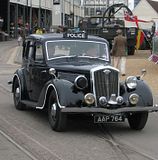




In terms of ships, you can explore three ships of very different eras.

HMS Gannet is a Doterel-class screw sloop built on the River Medway in 1878, designed to patrol the oceans and protect British interests and trade. It was powered by both sail and steam. In reality, it isn't that impressive, because they have removed its guts and it feels like a ship-shaped room instead of a proper ship.
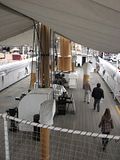 Until 1883, the Gannet spent much time shadowing the events of the War of the Pacific. She then became an anti-slaver in the Mediterranean. In 1903, she finished her operational career by becoming a training ship in the Thames. Hardly the sort of stuff that impresses tourists. A few months ago, we visited the 16th century replica Golden Hind in Southwark, which oozes adventure in the high seas. We were foolish to expect anything similar from the HMS Gannet, which was a bit unfair considering that HMS Gannet was the real deal and not a replica.
Until 1883, the Gannet spent much time shadowing the events of the War of the Pacific. She then became an anti-slaver in the Mediterranean. In 1903, she finished her operational career by becoming a training ship in the Thames. Hardly the sort of stuff that impresses tourists. A few months ago, we visited the 16th century replica Golden Hind in Southwark, which oozes adventure in the high seas. We were foolish to expect anything similar from the HMS Gannet, which was a bit unfair considering that HMS Gannet was the real deal and not a replica.The second ship is HMS Cavalier, a world war 2 C-class destroyer. It is of course a privilege to walk inside it and on its deck and I have no doubt that the chaps at Chatham do their best to preserve it, but it doesn't really compare to say the HMS Belfast or the Averof, where you are free to go to almost every part of the ship and even deep down the lower decks.

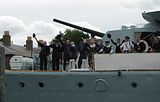


The third one though was really worth the visit. It is the Cold War submarine HMS Ocelot; the last one to ever be built in the Chatham dockyards (1962, I think). By the way, the dockyard had started building submarines when modern ships got too big to fit into the Medway river. The tour in the submarine does not last much, just 10-15 minutes, but it truly is incredible; reminiscent of "Das Boot". If you ever get there, try to move inside by properly grasping the handle and jumping into the next room! The guide will show you how to do it. Taking photos is prohibited, but I couldn't resist.
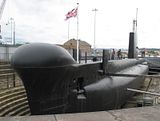

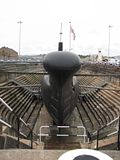
In the same area there is also a museum of maritime models and paintings, a steam train used for carrying stuff, an old double decker bus, a fire brigade station and a police museum with very interesting crime exhibits.




